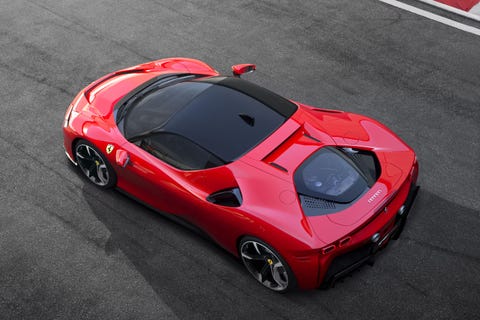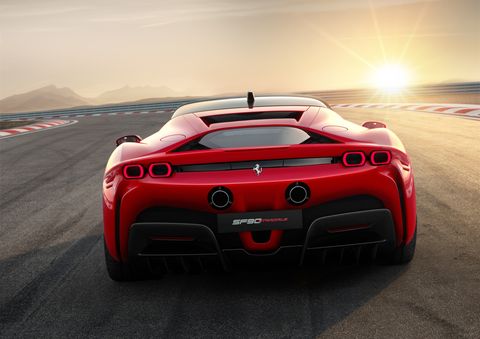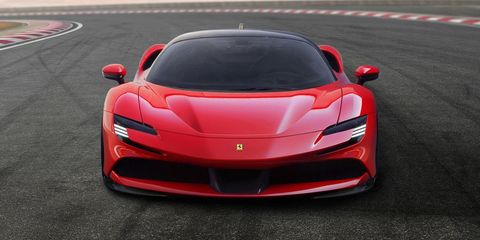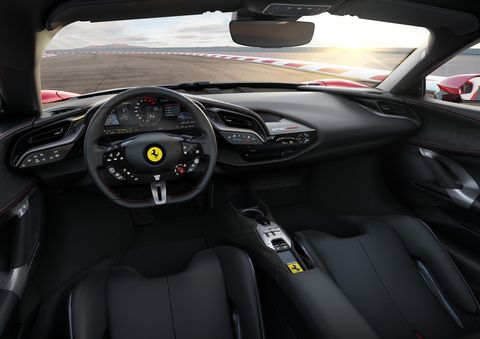The EXP 100 GT celebrates 100 years of Bentley
The second thing you notice is the grille, which isn’t really a grille at all because the EXP 100 GT – a glimpse of how the Bentley GT of 2035 might look – is of course powered by electricity. The company claims a range of around 430 miles, a top speed of 186mph and 0-60mph in 2.5 seconds were it, y’know, a real thing…
The ‘grille’, then, serves a different purpose. It’s made of a kind of clear acrylic, and incorporates many individually-controlled LEDs so it can effectively ‘communicate’ with passers-by. The pattern changes depending on whether the car is in autonomous mode – it’s “see or be seen”, as Bentley designer JP Gregory puts it.
Then there’s the aesthetic argument. Gregory says: “There’s a lot of start-up brands at the moment – like Lucid and Faraday Future. And they’re all really handsome cars actually, but one thing they all don’t have is a particular identity.
“As a designer it’s ying and yang, because it really appeals to me to have a blank sheet of paper. But it’s also a disadvantage, because all of them follow the zeitgeist of what’s cool now. So they all end up looking quite similar. To have that rich and deep heritage to draw from is an advantage. Why ignore it? You have to look at a car and instantly know it’s a Bentley.”
The EXP’s electric-ness also means that if you look closely, its proportions are a bit off. Not bad-off, but different-off. Usually a car like this is all bonnet, but the Bentley is a good 80 per cent cabin. “The front screen is much further forwards than we’re used to on a Bentley,” Gregory acknowledges. He says this is partly because they don’t need to leave room under the bonnet for a big W12, but it’s mainly driven by the car’s “drive or be driven” concept that demands much interior space.
Despite its size, the EXP 100 GT seats only four. Or sometimes just two, depending on how you configure the clever seats. Admittedly in glorious opulence, surrounded by the world’s finest materials. Such as 5,000 year-old oak dredged-up after millennia spent underground, and leather made not from animal hide, but grape pulp left over from fine wine-making. Yes, really. The attention to detail in here really is something – far above and beyond what you’d normally expect to see in a concept.
Bentely says the interior is designed to boost the “physical and mental wellbeing of passengers”. There’s lots of light thanks to the exquisitely intricate glass roof, while biometric sensors monitor eye and head movements, blood pressure and so-on then adapt the car to suit. Everything is managed by the Bentley Personal Assistant AI, which passengers can interact with by waving their hands over crystal ornaments.
Its ‘Enhance’ mode is supposed to replicate the feeling of open-top motoring, by interpreting the conditions outside and to an extent replicating them inside. ‘Cocoon’, meanwhile, ups the level of air purification and turns many of the windows opaque. ‘Capture’ records significant moments on your drive, which can then be replayed with the ‘Re-Live’ function.
In-car displays are mainly transparent OLEDs, which is why it looks like there aren’t any, and there’s an interesting cartridge system that delivers items from under the car’s bonnet into the cabin. The double-bubble design of the dash is reminiscent of Bentley’s current models, though here the steering wheel is not a permanent fixture. It motors back into the dashboard when you’re letting the car do the driving.
It sounds like the EXP is possessing of much seemingly pie-in-the-sky tech. But Bentley insists pretty much everything on the EXP 100 GT is being worked on by its designers and engineers. From the Bentley Personal Assistant AI to the transparent OLED displays and adaptable tyres/wheels – Bentley says there’s a “roadmap” for pretty much all of it.
Which is why as concepts go, the EXP 100 GT isn’t especially wild. Certainly not as wild as some of the stuff that comes out of France, for example. Everything is rooted in reality, to a greater or lesser degree.
If Bentleys looked like this in 2035, would you save a space for one on your lottery-win shopping list?
By: Tom Harrison, July 10, 2019
For more cars, visit: https://www.topgear.com/car-news/british/exp-100-gt-celebrates-100-years-bentley
Source: https://www.topgear.com/
The Aston Martin DBS GT Zagato Won’t Have a Rear Window

Aston Martin gave us our first look at the upcoming DBS GT Zagato a few months ago in the form of three sketches, but the British brand has now released three full-fledged renderings that show the limited-run grand tourer in its unexaggerated final form—its digital final form, at least.
The three new renderings show the DBS GT alongside the already revealed DB4 GT Zagato, which completes the second half of the pairing that Aston has dubbed the DBZ Centenary Collection. Together, the two cars will cost just under $8 million, only 19 of each will be made, and you can’t buy them separately. While the DB4 is an exact replica of the original car from the 1960s, the DBS is a wholly modern car based on the existing DBS Superleggera.
From the front, the DBS GT immediately looks distinct from its “regular” DBS siblingthanks to the gaping maw of a grille. Said grille is made up of 108 carbon-fiber 3D pieces that are closed when the car is off, appearing flush with the body. But when the car starts up, the diamond-shape pieces “flutter into life,” opening up to allow airflow to the V-12 engine. There are new triangular headlights and a big hood vent, too, and the front overhang and hood look longer.
From the side, the DBS GT has a prominent finlike fender vent that’s capped by gold trim, which echoes the gold trim on the wheels and the grille. The rear fenders have a sharp crease, and the C-pillar sharply kicks up to meet the roof. And it’s the roof that’s the DBS GT’s real parlor trick and sets it apart from pretty much every other car on sale.
The double-bubble roof, a classic Zagato hallmark, is made from a single piece of carbon fiber that extends from the top of the windshield all the way back to the trunk. That means there’s no rear window, not even a tiny sliver of one. Instead, a camera at the back of the car projects the rearward view onto a screen that is mounted where a typical rearview mirror would be. According to Aston, this setup has no compromises on practicality to the driver, and head of design Marek Reichman says its one of the rare cases where form and function meet, with no concessions given to either side.
The rest of the rear end is a bit more typical, with a huge carbon-fiber diffuser housing quad exhaust tips, clear-lensed taillights with a fluted design like those on the Vanquish Zagatos, and a carbon-fiber panel that looks like it might have an active rear spoiler. And yes, there is still a trunk, although Aston doesn’t say how large it is.
While the DB4 GTs are already being built and delivered, the DBS GTs won’t enter production until next year. Expect to see the first one possibly make its debut in the metal at an auto show or event later this year.
By: Daniel Golson, July 9, 2019
For more cars, visit: https://www.caranddriver.com/news/a28336129/aston-martin-dbs-gt-zagato-design-renders/
Source: https://www.caranddriver.com/
The Shelby GT500 will Produce 760bhp
Earlier this year, Ford told us that its impending Shelby GT500 would have ‘a projected 700 horsepower’. Seems those projections were a tad… conservative, because, ladies and gents, the all-new 2020 GT500 will produce a whopping 760 horsepower and 625lb ft. of torque. Those crazy numbers make it the most powerful street-legal Ford ever. Not only that, it’s the most powerful and torque-dense supercharged production V8 engine in the world. Dearborn, Michigan – take a bow.
This news brings a few immediate consequences. 1) you can bet your bottom dollar it’ll be pretty rapid 2) YouTubers are set to make a fortune from ad revenue when enthusiastic GT500s leave Cars and Coffee events in 2020.
As a refresher, the GT500 has a 5.2-litre supercharged V8 engine and, with these new power figures, promises 0-60mph in the mid-3sec range, and quarter mile times below 11 seconds. What’s going to stop it when it crosses the line? The largest brake rotors ever fitted to an American sports coupe, of course.
The upgrades for the new GT500, which goes on sale this autumn, are pretty mouth-watering across the board. The all-aluminium engine is hand-built, with forged conrods. In a purist-upsetting move to improve drag and lap times, there’s a seven-speed dual-clutch gearbox good for 100 millisecond shifts. It’s not the same transmission as the Ford GT supercar, but its fine-tuning is related to the GT’s. You get Normal, Weather, Sport, Track and Drag modes, and yes, it’ll do a line-lock burnout.
Power is sent to the bespoke Michelin-tyred rear wheels via a carbon fibre driveshaft. Ford describes the next-gen magnetic dampers as ‘baked-in’ (no, us neither) but we are promised the highest ever lateral acceleration for a Mustang. We’d expect nothing less.
Helping harvest those pesky G-forces is a GT4 racecar spec aero package, complete with an adjustable rear wing. Spec the carbon fibre pack and it comes in the glossy weave finish. So does the splitter. And the wheels. Meanwhile, the rear seats are replaced with fresh air.
There’s more hardcore stuff, like a removable rain-catching tray under the massive bonnet vent. If you live somewhere rather warmer and drier than the Top Gear office, you can ditch the rain guard and help your cooling. The giant holes in the car’s face help it achieve 50 per cent better cooling than the Shelby GT350 too. So, that big ol’ motor ought to sustain repeated abuse on track.
Guess there’s only one way to find out. Stay tuned for when we drive the car soon. And how would you prefer your 700 horsepower – in the shape of an American muscle car, or something a little more Italian, say a Ferrari 812? Let us know below.
By: Rowan Horncastle, June 19, 2019
For more cars, visit: https://www.topgear.com/car-news/usa/shelby-gt500-will-produce-760bhp
Source: https://www.topgear.com/
The Aston Martin Valkyrie’s ‘Valhalla’
It also continues Aston Martin’s tradition of naming its cars with things starting with a ‘V’. You know, Valkyrie, Vanquish, Vantage. Though, much to Top Gear’s sadness, Aston didn’t name the new RB 003 ‘Val Doonican’. Or ‘Val Kilmer’. Maybe it’s saving that for another mid-engined hypercar. We live in hope.
Anyway, the Valhalla. It’ll be a serious track-honed thing, underpinned by knowledge gleaned from the top dog Valkyrie. Y’know, the one that’s racing at Le Mans in a couple of years. Expect then, lots of aero and lightweighting (via a carbon body, carbon tub) and a twin-turbo “high output” V6 petrol engine with a battery-electric hybrid setup. Power and performance figures haven’t yet been released, but we suspect they shall be mighty.
Only 500 Valhallas will be produced, alongside the other mid-engined supercar Aston is developing – that’s the next-generation Vanquish, suiting up to fight the mid-engined Ferraris and McLarens of this world.
“Aston Martin model names always attract a lot of attention,” explains Aston boss Andy Palmer. “They do so because they invariably capture an emotion or tell a story.
“Norse mythology contains such powerful language and rich storytelling it felt only right that the AM-RB 003 should follow the Valkyrie’s theme,” he added. Yeah, but Val Doonican wore a cardigan. That’s rich storytelling too.
Still, naming your mid-engined, baby track monster after a mythical hall of fallen Asgardian warriors is… pretty cool, no?
By: Vijay Pattni, June 18, 2019
For more cars, visit: https://www.topgear.com/car-news/supercars/aston-martin-valkyries-baby-brother-called-valhalla
Source: https://www.topgear.com/
This DB4 GT Zagato Continuation Is the Most Expensive “New” Aston Martin Ever Built

Aston Martin is taking advantage of the trend of building brand-new factory continuations of vintage cars, revealing several new/old models built in limited numbers. The latest is this DB4 GT Zagato continuation, first announced last year. Aston has just completed the first one, and it’s a stunner.
Painted in Rosso Maja red over Obsidian black, DB4 GT Zagato continuation No. 1 sports a 4.7-liter straight-six engine sending over 390 horsepower to the rear wheels via a four-speed manual transmission and a limited-slip differential—a healthy improvement over the original’s 314-hp, 3.7-liter powerplant. Inside sits an FIA-approved roll-cage and carbon fiber bucket seats, while Borrani knock-off wire wheels round out the design. Like the Goldfinger DB5 continuation cars that came before it, this car is technically considered a brand-new vehicle—and thus, it’s not street-legal, as it doesn’t meet any of today’s safety or emissions standards.
How the 2020 Flying Spur is Everything a Bentley Sedan Should be
Third time’s the charm. The 2020 Bentley Flying Spur banishes forever the visual awkwardness of its two Phaeton-platformed predecessors. It’s long and low, expressively elegant, and glitteringly powerful, with just a soupcon of the jaunty exuberance that’s at the heart of the brand. It’s exactly how a modern Bentley sedan should be.
The enabling technology, of course, is VW Group’s versatile MSB vehicle architecture. Designed to accommodate longitudinally mounted engines all the way up to the 6.0-liter W-12, with all- or rear-wheel drive, MSB has allowed the team under Bentley design chief Stefan Sielaff to give the new Flying Spur classic British luxury car proportions. The 2020 model is a mere 0.6 inches longer than the outgoing car, but its front axle centerline is 5.1 inches further forward, allowing a long hood without a pronounced front overhang. It’s the singular dimensional change that, visually, changes everything.
The MSB architecture debuted on the Porsche Panamera and now also underpins the current Continental GT. In Flying Spur configuration—the largest vehicle yet built on MSB—it shares all the structure ahead of the firewall with the Panamera and Continental GT, and its center section with the long-wheelbase Panamera Executive. The rear section of the platform, however, from the base of the rear seatback, is unique to the Bentley. It allows for a more comfort-oriented suspension setup and a roomy, conventional trunk instead of the Porsche hatchback.
ll exterior panels are aluminum—Bentley claims the new multi-metal body structure is 84 pounds lighter than the outgoing Flying Spur’s. Key design elements include a broad grille with classic vertical slats, crisply defined haunches over the rear wheels, and a C-pillar that sweeps down into the trunk, which falls away slightly to give a hint of the graceful tail-down stance characteristic of the original H.J. Mulliner-bodied Flying Spur of the late 1950s. Standard wheels are 21 inches, with two different 22s available as an option.
Under the hood is the latest iteration of the 6.0-liter W-12, first seen in the Continental GT Coupe and Convertible. That means 626 horsepower, and a herculean 664 lb-ft of torque that arrives in less than one-third the time it took in the previous car. As in the Contis, the engine drives all four wheels through an eight-speed dual-clutch transmission. And despite lugging around extra doors and larger rear seats, Bentley claims the Flying Spur will be just as quick as the Continental GT Convertible, hitting 60 mph in just 3.7 seconds with a top speed of 207 mph. To cope with its prodigious turn of speed, the Flying Spur uses the same 16.5-inch front brakes—the largest iron brake rotors in the world—as the Continental GTs.
The new Flying Spur promises to be a much sportier drive than previous models, with sharper turn-in response, less understeer, and better chassis balance. The three-chamber air springs—similar to those fitted to the Continental GTs—have 60 percent more capacity, allowing for finer degrees of adjustment, and the 48-voly anti-roll system uses electric motors to twist the rollbars against the cornering loads keeping the car flat through turns.

Although the Flying Spur is all-wheel drive, the torque split is resolutely biased to the rear: Comfort and Normal modes allow a maximum of 38 percent of the torque to be sent to the front wheels, but selecting Sport mode caps that at 17 percent. Finally, the Flying Spur will come standard with rear-wheel steering—the first ever Bentley to be so equipped—to improve agility in tight corners and enhance stability through high-speed sweepers.
Modern Bentley interiors have become a byword for extraordinarily rich combinations of color and materials, and the 2020 Flying Spur’s interior is arguably the best yet. Bentley offers no fewer than 15 different standard leather colors, and these can be mixed and matched via a number of dramatic color splits. In addition, buyers can choose from eight different wood veneers, including a new crown-cut walnut, and all can be ordered in the dual veneer specification to give the cabin an even more bespoke feel. The Flying Spur interior’s showstoppers are an optional three-dimensional diamond quilting effect—in leather or wood—on the door trims, and an optional etched finish on the center console made up of 5,331 individual diamond shapes, each different from the others.
The MSB hardware includes a new electrical architecture, so the 2020 Flying Spur comes equipped with a host of driver assistance systems, including traffic and blind-spot warning, as well as night vision, a head-up display, a 360-degree overhead view camera system, and parking assist. When you press the engine start button, the veneered section in the middle of the dashboard rotates to reveal the 12.3-inch HD touchscreen shared with the Conti twins. The second side of the display reveals three analog dials showing outside temperature, a compass, and a chronometer. Those wanting what Bentley calls a ‘digital detox’ can select a third side, which is simply finished in plain veneer matching the rest of the cabin.
Rear-seat passengers can control a number of functions—including window blinds, rear seat massage, rear climate control, and mood lighting—via a 5.1-inch touchscreen remote that unclips from the rear of the center console.

Flying Spur buyers can choose from three audio systems. The standard system has 10 speakers and 650 watts. Next up is a 1,500-watt, 16-speaker Bang & Olufsen system with illuminated grilles and the intuitive one-touch BeoSonic user interface. Top of the range is a monster 2,200-watt Naim for Bentley system with 19 speakers and active bass transducers built into the front seats.
The 2020 Bentley Flying Spur will be available for order this fall, with first deliveries expected early next year. No word on pricing yet, but if Bentley follows past form and prices and the new Flying Spur rings in below a comparably equipped Continental GT Coupe, this impressively fast, imposingly glamorous four-door could well be the pick of the Bentley lineup.
By: Angus MacKenzie, June 11, 2019
For more cars, visit: https://www.motortrend.com/cars/bentley/flying-spur/2020/2020-bentley-flying-spur-first-look-review/
Source: https://www.motortrend.com/
The 2020 BMW M8 Packs up to 617 Horsepower and Selectable All-Wheel Drive
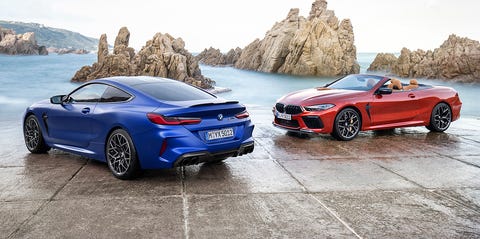
After numerous leaks and several spy videos from the Nurburgring, BMW has finally revealed the M8—the spiritual successor to the recent M6 and the very top of the company’s performance lineup. Available as a coupe or convertible, it packs the twin-turbo V-8 and all-wheel drive powertrain from the M5, along with a whole bunch of other improvements over the lesser M850i that we reviewed in late 2018.
The base M8 coupe and convertible produce 600 horsepower and 553 lb-ft of torque, while Competition models get an extra 17 hp. Performance promises to be exceptional: BMW says the standard M8 coupe is capable of 0-60 mph in just 3.1 seconds, and the convertible will do it in 3.2. With the Competition package, those numbers drop by a tenth. Top speed for all models is electronically limited to 155 mph, increasing to 189 mph with the optional M driver’s package.
Like the M5, the M8’s all-wheel drive system has three selectable modes: A default 4WD setting meant for normal driving, a 4WD Sport setting that sends more power to the rear wheels, and 2WD mode that’s only active when stability control is turned off. An active rear differential works with the car’s M Dynamic mode to allow a degree of wheel slip for controlled oversteer.
Lamborghini Huracan Serrato First Look: The Off-Road Supercar

Like the Spanish Inquisition, nobody expects the Sterrato! But here we are. Yes, friends, you are looking at a jacked-up, armor-plated, balloon-tired, off-road Lamborghini Huracán. For real? Yes, Lamborghini really built one. In fact, it built more than one, and I’ve already driven it, but drive impressions are embargoed until June 12. Because I can’t tell you if it’s any good (hint: no comment), allow me to share some details.
The Sterrato exists because while Lamborghini was developing the Urus, the engineering team fell in love with off-roading. As you might imagine, the makers of Aventadors and Huracáns had zero experience playing around in sand, mud, and gravel. As any off-roading aficionado can tell you, dirt’s a lot of fun! The Lamborghini team took what it learned from the Urus and applied it to a Huracán. Sterrato, roughly translated, means “dirt road.” The result is something truly unique. As Lamborghini the brand is fond of saying, “Expect the unexpected.”
Four big things turn a 630-hp Huracán Evo into a Sterrato. First comes stance. Lamborghini added 47mm (1.85 inches) of ride height while widening the track by 30mm (1.2 inches) front and rear. Next comes big, fat off-road tires. Made by Pirreli, the prototype meats are much, much fatter than the typical rubber found on a supercar. The sidewall looks to be three times thicker. So thick, in fact, that the front axle had to be moved forward, which required new front control arms. Moreover, the widened track necessitated the 3-D printing of new fenders front and rear.

After that came the armor. The nose, side sills, and rear end all get tough aluminum cladding. Lamborghini claims the plating was added to the spots that took damage during testing. And because the Sterrato is a Lamborghini, the rear piece is a functional diffuser. You can also see shields in front of the huge side intakes. Gotta keep the rocks out. Finally, the Evo’s Lamborghini Dynamic Vehicle Integration (LDVI) computers have been reprogrammed for dirt roads. LDVI controls the magnetic dampers, the torque-vectoring AWD, all-wheel steering, traction control, and the predictive yaw control (Lamborghini Piattaforma Inerziale).
Lamborghini also tossed on some hella-bright LED light bars for good measure. Why not?
The decision to put the Sterrato into production hasn’t been made. Yet. Is there a business case? Sure, assuming people buy them. Will people buy an off-road supercar? That’s the multimillion-dollar question. I imagine Ford went through a similar process when deciding whether to put the Raptor into series production. I believe we can all agree that flying truck is a runaway success story. This is different, but in a way, it’s not that different. Of course, the deciding factor for production will no doubt be how the Sterrato drives, especially off-road. In just eight short days from now, I’ll tell you all about it. Until June 12!
By: Jonny Lieberman, Jun 4, 2019
For more cars, visit: https://www.motortrend.com/cars/lamborghini/huracan/2020/lamborghini-huracan-sterrato-first-look-review/
Source: https://www.motortrend.com/
Jaguar XE SV Project 8 First Test: Exclusive and Extreme

The Jaguar XE SV Project 8 has an insatiable appetite for breaking records. First, it shattered the four-door production sedan lap time at the Nurburgring with a time of 7:21.23. That’s 11 seconds quicker than the Alfa Romeo Giulia Quadrifoglio, the former record-holder and our 2018 Car of the Year. Then, just last year, MotorTrend pro racer Randy Pobst set a production sedan lap record of 1:37.54 at WeatherTech Laguna Seca, eclipsing the 1:38.52 set previously by a 2016 Cadillac CTS-V.
What else would you expect from a Jaguar XE that looks like it’s been injected with massive amounts of steroids and carbon fiber? With a supercharged 5.0-liter V-8 cranking out 592 horsepower, the Project 8 is also Jaguar’s most powerful roadgoing car to date.
But in light of these accomplishments, Jaguar insists that it’s a worthy roadgoing car as well. That’s right—despite the bespoke bodywork, the pavement-sniffing splitter, and the massive wing out back, “compromise was not in the nature of this product,” according to one of the Project 8’s lead engineers. And you know what? They’re right. Out on the road, the Project 8 is comfortable—even practical. Although EPA estimates fuel economy to be 16/22 city/highway, we observed an indicated 25 mpg during extended stints on the freeway. This fearsome cat is also a cuddly kitty.
Then again, it had better be. The base price of the Project 8 is a blood-chilling $188,495. That’s far more than such four-door performance heavyweights as the BMW M5 ($104,595), the Mercedes-AMG E 63 S ($105,395), or the Porsche Panamera Turbo S E-Hybrid. It’s more than twice the price of the aforementioned Alfa, which starts at a comparatively thrifty $75,590. None of these models, however, can boast a claimed 200-mph top speed. So there’s that.
Our Velocity Blue tester featured a slew of options that were thoughtfully included at no cost. Some were appreciated, such as the 825-watt Meridian sound system and the trick 20-inch wheels, whose design resembles reverse five-spokes. We could have done without the giant cat vinyl decal gracing the flanks of the sheetmetal, however. And for a record-breaking sports car, the front seats are a letdown. While the upper portion cradles the torso nicely, the bottom offers no lateral support to speak of. Outside of North America, buyers can choose a two-seat Track Pack option that offers carbon-fiber shells with four-point harnesses. Lucky.

This Is the SF90 Stradale, The Most Powerful Ferrari Ever
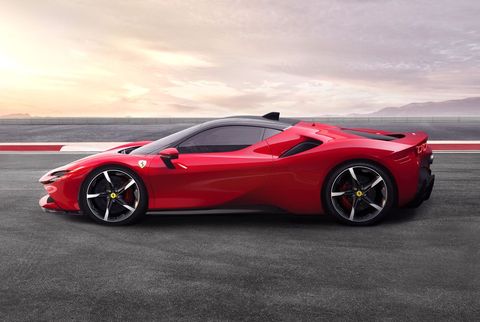
This is the future of Ferrari: Meet the SF90 Stradale, the automaker’s first mainstream production plug-in hybrid hypercar. It packs 986 horsepower from a twin-turbo V-8 augmented by three electric motors, and it establishes itself as Ferrari’s new pinnacle.
This marks the first time a V-8 car has occupied the top of the Ferrari lineup. The SF90’s drivetrain centers around a modified version of the company’s twin-turbo V-8. Bored out to 4 liters of displacement and blessed with improved intake and exhaust routing, the engine makes 769 hp and 590 lb-ft of torque on its own.
An additional 217 hp comes from three electric motors—one powering each front wheel, and one stacked between the engine and gearbox. Powered by a 7.9 kWh lithium-ion battery mounted just behind the passenger compartment and spanning the width of the chassis, the car can cover up to 15.5 miles in electric-only mode, and can reach a maximum speed of 84 mph on battery power. A humorous point: Technically, when operating in EV-only mode, this is the world’s first front-wheel drive Ferrari.
But the hybrid system isn’t just there to save fuel. This is the first mid-engine Ferrari supercar with all-wheel drive, and the SF90 Stradale uses all that traction for major acceleration. Ferrari promises the car will do 0-62mph in 2.5 seconds and 0-124mph in 6.7 seconds, quicker than the V-12 hybrid LaFerrari. The electric motors powering each front wheel also enable real-time front-axle torque vectoring for improved handling on track.
The SF90 Stradale features an all-new eight-speed dual-clutch transmission. The dry-sump gearbox allows the drivetrain to sit 15 mm lower than the previous seven-speed dual-clutch, lowering the car’s center of gravity. The additional gear makes up, in part, for the relatively low redline of the updated V-8 engine—8000 RPM, compared to the LaFerrari’s 9250-rpm V-12. Notably, the transmission does not have a reverse gear—the car backs up using the front-wheel electric motors, a strategy also used in the Acura NSX.
In person, the engine appears to sit impossibly low in the chassis. Peering through the glass engine cover, there’s about two feet of open-air space above the engine itself. You could slide a carry-on suitcase in the space, if you weren’t afraid of it catching fire.
The SF90 Stradale’s interior embraces minimalism. There are no physical buttons anywhere on the dashboard—pretty much everything is capacitive touch. Nearly every driving-related control is located on the steering wheel, while climate controls reside on a capacitive-touch pod to the right of the steering wheel. Gear selection is done by three push-pull toggles on the transmission hump, designed to be reminiscent of a gated manual shifter, while steering wheel paddles handle up- and downshift duties.
The instrument panel is entirely digital, made up of a giant 16-inch curved display screen that encompasses gauge readouts and navigation display. This is also the first Ferrari road car with head-up display.
As with all modern hypercars, the SF90 Stradale has active aero features. Instead of a rear spoiler that rises above a certain speed, the new Ferrari’s rear aero activates by lowering a wedge-shaped panel directly ahead of the rear edge of the bodywork, revealing a large Gurney flap-style spoiler. This fast-acting aero system allows the car to go into low-drag mode on straightaways and increase downforce under braking or cornering. The system can generate up to 860 lbs of downforce at 155 mph.
An even higher-performance version, the SF90 Stradale Assetto Fiorano, will be available as well. Shown here in silver, the Assetto Fiorano features upgraded shock absorbers, lightweight titanium springs and exhaust, carbon-fiber wheels and other weight-savings measures for a total of 66 lbs of weight savings. Thus equipped, the SF90 weighs in at 3461 lbs dry—certainly not light, but a few pounds less weighty than the LaFerrari. The Assetto Fiorano also offers greater downforce and more grip thanks to Michelin Pilot Sport Cup2 tires (an upgrade from the standard-equipment Pirelli P Zeros).
This is the first Ferrari to use brake-by-wire technology, allowing braking duties to be split between the traditional hydraulic system and the regenerative capability of the electric motors. The hybrid Acura NSX uses a similar system, as does the Alfa Romeo Giulia and Stelvio. Our experience with the Alfa system has been less than ideal, so we’re curious to see how brake-by-wire works in Ferrari’s application.
The SF90 Stradale is named to commemorate the 90th anniversary of the founding of the Scuderia Ferrari racing team. As such, it’s meant to embody the flow of technology from Ferrari’s racing operation to its road cars. In person, the SF90’s voluptuous bodywork evokes Ferrari prototype racers of the 1960s and ’70s, while the hybrid technology nods to modern Formula 1. In total, the SF90 Stradale is a stunning new direction for Ferrari, one that’s sure to influence many of the next-generation models the automaker promises will debut soon. As for price? Ferrari representatives would only say that the SF90 Stradale will be more expensive than the current F12 Tributo, but less than the LaFerrari. Deliveries begin in the first quarter of 2020.
By: Bob Sorokanish, May 29, 2019
For more cars, visit: https://www.roadandtrack.com/new-cars/future-cars/a27626676/ferrari-sf90-stradale-hybrid-hypercar-power-specs-photos/
Source: https://www.roadandtrack.com/






















